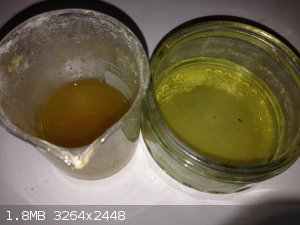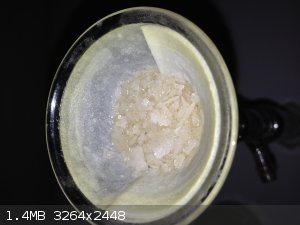LearnedAmateur
National Hazard
   
Posts: 513
Registered: 30-3-2017
Location: Somewhere in the UK
Member Is Offline
Mood: Free Radical
|
|
Acetaminophen purification issue
The background for this is that I'm going to attempt an alkaline hydrolysis of paracetamol (I've unsuccessfully attempted an acid hydrolysis
beforehand) for producing para-aminophenol.
I was hoping to extract some pure paracetamol from tablets, separating it from the binders, fillers, and whatever else is in them (it doesn't say
exactly what they are on the packet). I initially tried a hot water extraction, with the aim of crystallising out the paracetamol as it cooled, after
filtration of course, but this didn't really work as the solution cooled too quickly and clogged up my filter paper.
I then tried using isopropyl alcohol, the idea being that paracetamol would hopefully be more soluble hence appropriate for recrystallisation. This
was done somewhat successfully, and I now have a beaker which contains some crystalline paracetamol.
What surprised me was that the solution turned dark yellow during the course of this. Does anybody have any ideas as to what is responsible? It also
occurred in the aqueous solution, but didn't turn as dark as the isopropyl alcohol solution. I didn't add anything but the crushed tablets, and the
aqueous solution was made up using ordinary tap water which shouldn't be the cause

In chemistry, sometimes the solution is the problem.
It’s been a while, but I’m not dead! Updated 7/1/2020. Shout out to Aga, we got along well.
|
|
|
JJay
International Hazard
    
Posts: 3440
Registered: 15-10-2015
Member Is Offline
|
|
I've done this before and also noticed some weird colors, namely pink and a mottled grey color that made it look like my acetaminophen was literally
moldy. I think that small amounts of acetaminophen degrade to form very intensely colored products. I've seen lab instructions that suggested cleaning
up acetaminophen with dithionate.
The fastest and easiest way to get a fairly pure product is to microwave the crushed tablets in acetone, filter, and then crash out the acetaminophen
with water.
|
|
|
LearnedAmateur
National Hazard
   
Posts: 513
Registered: 30-3-2017
Location: Somewhere in the UK
Member Is Offline
Mood: Free Radical
|
|
Yeah I've played around with paracetamol before, made some dark red irregular crystals when combined with FeCl3, I guess it's just one of those
unpredictable molecules. I don't have any dithionate on hand but as you can see from the picture my paracetamol is good as pure for my needs, I was
really just wondering what caused the intense colouration - strange that it didn't turn out how yours did.
Haven't tried microwaving any mixtures yet so I'll give that a go when I next need to prepare some, thanks for the tip.

In chemistry, sometimes the solution is the problem.
It’s been a while, but I’m not dead! Updated 7/1/2020. Shout out to Aga, we got along well.
|
|
|
nitro-genes
International Hazard
    
Posts: 1048
Registered: 5-4-2005
Member Is Offline
|
|
Acetaminophen can be deactylated by using concentrated acids, IIRC using 50-70% sulfuric at near the bp of acetic acid (121 deg C), the acetic acid
smell is quite noticeable, the solution of the acid salt of aminophenol is not as susceptible to air oxidation as using alkaline hydrolysis and hardly
any colouration is observed.
Depending on the brand, the tablets are likely to contain titanium dioxide, magnesium stearate, starch, polyvinylpyrrolidone (PVP) and bisulfite as
preservative. The PVP is most annoying, best to avoid tablets containing this, it enhances the solubiity of acetaminophen in water leading to lowered
recovery and can coprecipitate IIRC. Dissolving the tablets in a minimum of 20-50 deg C. acetone , ethanol or isopropanol and letting this evaporate
ASAP is enough to get rid of most impurities, except for trace amounts of starch and significant amounts of magnesium stearate The latter can be
removed by a recrystallization from boiling water or 50-50 water-ethanol, filtering it out of the hot solution, prior to cooling.
Halfway this thread you can find a pdf listing solubilities of acetaminophen in different solvents:
https://www.sciencemadness.org/whisper/viewthread.php?tid=62...
[Edited on 7-12-2017 by nitro-genes]
|
|
|
LearnedAmateur
National Hazard
   
Posts: 513
Registered: 30-3-2017
Location: Somewhere in the UK
Member Is Offline
Mood: Free Radical
|
|
The reason I was going to try the alkaline hydrolysis is that my last experience with the alternative resulted in a dark red-purple solution with
black gunk precipitating out, and there was a brown coating on the glass which really didn't want to budge but happily dissolved in isopropyl nitrite.
I was thinking of stoichiometrically hydrolysing it to create sodium acetate and free aminophenol in about 20mL of NaOH solution at a low boil for
30-60 minutes, filter at <10C, and dissolve in hydrochloric acid for crystallisation. Would this be a good plan providing a bit of loss is
acceptable? I'm not too anal when it comes to yields, and I haven't weighed it yet since it's drying, but I believe I have about 2-3 grams of
paracetamol - can always extract more if things go awry.
In chemistry, sometimes the solution is the problem.
It’s been a while, but I’m not dead! Updated 7/1/2020. Shout out to Aga, we got along well.
|
|
|
WangleSpong5000
Hazard to Others
  
Posts: 129
Registered: 3-11-2017
Location: Oz
Member Is Offline
Mood: Curious
|
|
Brand difference can be huge in regards to the inactive constituents of the tablets. Some are reasonably devoid of particularly annoying fillers
producing noticeable paracetamol crystals from a cold water extraction alone, while others result in a thick viscous emulsion when dissolved in water.
|
|
|
LearnedAmateur
National Hazard
   
Posts: 513
Registered: 30-3-2017
Location: Somewhere in the UK
Member Is Offline
Mood: Free Radical
|
|
Yeah, I've used a couple of different shop bought brands, some settle quickly and result in a clear solution, others notable cloudiness, and I've even
found that some create a thick emulsion of sorts that foam when shaken which likely indicates the presence of PVP and isn't removed by washing off the
film coating. I seemed to have been lucky here, even under a rolling boil the extraction went smoothly aside from the colour change so there must've
only been a minimal amount of impurities. I should really start weighing up the tablets beforehand and checking them against the removed byproducts.
In chemistry, sometimes the solution is the problem.
It’s been a while, but I’m not dead! Updated 7/1/2020. Shout out to Aga, we got along well.
|
|
|
WangleSpong5000
Hazard to Others
  
Posts: 129
Registered: 3-11-2017
Location: Oz
Member Is Offline
Mood: Curious
|
|
In Oz there is a specific brand of paracetamol that is most well known and most heavily marketed and were the first to market paracetamol + codeine
combined tablets, or at least they had a massive market share. Doing any kind of extraction on these particular tablets has always been quite easy.
Then as a multitude of other brands released there own cheaper version of the drug the number of inactive ingredients appered to increase or at least
began to contain things that make extraction much more difficult.
There's really nothing too hard to get around in tablets of this nature. Yield would defiantly be effected somewhat over different brands. That would
be an interesting project actually... to compare comparative yields.
|
|
|
LearnedAmateur
National Hazard
   
Posts: 513
Registered: 30-3-2017
Location: Somewhere in the UK
Member Is Offline
Mood: Free Radical
|
|
I've just been sticking to the paracetamol only tablets, got plenty with caffeine and phenylephrine for example as 'max strength' or whatever they're
labelled as but it's just extra stuff getting in the way. Definitely don't have access to the codeine ones considering they're all prescription only
in the UK, even pseudoephedrine formulations are gone from the shelves but that doesn't really bother me, especially not when it comes to the
chemistry.
I've decided to do another recrystallisation using some seed crystals now, should take a few days to evaporate down. I took a time lapse of a couple
drops worth evaporating under my ghetto microscope, pretty cool stuff to watch since it obviously occurs a lot faster than a macroscopic
crystallisation, made a channel just for it so I might start uploading more videos.
https://m.youtube.com/watch?v=g6-MuHhoEms&feature=youtu....
In chemistry, sometimes the solution is the problem.
It’s been a while, but I’m not dead! Updated 7/1/2020. Shout out to Aga, we got along well.
|
|
|
Boffis
International Hazard
    
Posts: 1836
Registered: 1-5-2011
Member Is Offline
Mood: No Mood
|
|
I have extracted a great deal of paracetamol from tablets and I have got it down to a fine art. I am away at present and don't have my notes to give
exact details but here are a few pointers.
1) The cheapest brands are the easiest to extract.
2) methanol and isopropanol are the best solvent but I use different methods according to the solvent. When use methanol I use enough solvent so that
the solution is just saturated at about 25-30 C because its a bugger trying to filter hot solutions quickly even with a pre-heated Buchner funnel,
particularly as some of the filler make filtration difficult. If the filtrate is slightly cloudy a very little active charcoal helps but be careful
since active charcoal seem to catalyze oxidation and the solution turns pink. The first crop of crystals of colourless but further crops are
progressively discoloured. The purified filtrate is then distilled until 50% of the solvent has been removed and cooled with stirring to give a fine
granular easily filtered product. The filtrate is then evaporated and a further 25-30% of the solvent is recovered and crystallized. With large
batches you can keep doing this but usually I recover the last portion by pouring the final residue slowly into hat water with vigorous stirring. If
you do this carefully and finally cool under stirring you recover most of the remaining paracetamol in a granular white form that is easily filtered.
3) With isopropanol I use a hot filtration and recover the paracetamol by cooling because it is much less soluble in cold isopropanol than in ethanol.
(there is a paper attached to a old thread somewhere on SM that contains details of paracetamol solubilities).
The solutions need to be processed as quickly as possible to limit the formation of coloured byproducts but I usually work with about 200g and it
takes me two days without problems; I get about 96-97% recovery.
The hydrolysis of this to p-aminophenol is very difficult because this is very sensitive to oxidation particularly in alkaline solution. The alkaline
method is not practical unless you have a means of working under an inert atmosphere. The Hydrochloric acid method is better, an excess of HCl is used
and charcoal treatment is necessary, on cooling the hydrochloride crystallises out in reasonable yield but my product has always been violet-brown
crystals. Further charcoal treatment with the addition of a reducing agent such as stannous chloride helps a little but with significant loss. In an
alkaline medium you may be able to use Na dithionite to limit oxidation.
|
|
|
LearnedAmateur
National Hazard
   
Posts: 513
Registered: 30-3-2017
Location: Somewhere in the UK
Member Is Offline
Mood: Free Radical
|
|
Thanks for the tips, I'd managed to get some nice paracetamol crystals going from the isopropyl alcohol but after drying some clumped into masses with
an off-white impurity, seemed that some of the contaminants got through the filter but my solution is crystal clear now.
What about conducting the hydrolysis in surgical spirit (denatured spirit with 10% water) to limit oxidation? Sodium hydroxide dissolves nicely in it,
and it should help to bring more paracetamol into solution for the reaction.
In chemistry, sometimes the solution is the problem.
It’s been a while, but I’m not dead! Updated 7/1/2020. Shout out to Aga, we got along well.
|
|
|